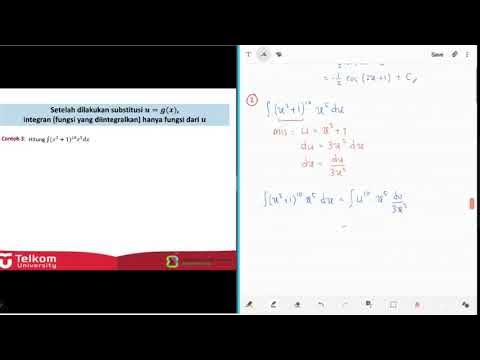The Dirichlet Integral is destroyed by Feynman's Trick
Summary
TLDRIn this video, the host demonstrates a powerful integration trick that helps solve difficult integrals, focusing on the integral of sine X divided by X. The trick involves introducing a parameter and differentiating with respect to it, a technique known as Feynman's trick, which simplifies the problem into a manageable form. By using integration by parts and Laplace transforms, the integral eventually evaluates to pi/2, known as the Dirichlet integral. The video also highlights the use of Maple Learn software for performing complex mathematical operations efficiently.
Takeaways
- 😀 The integral of sine(X) divided by X cannot be solved by traditional methods like partial fractions or substitution.
- 😀 The graph of sine(X) divided by X shows a decaying behavior, which plays a role in the convergence of its integral.
- 😀 A key trick introduced is using an exponential factor, e^(-sx), to make the integral more manageable.
- 😀 The integral becomes a function of 's', denoted as F(s), which can be manipulated more easily for different values of s.
- 😀 Feynman's trick involves differentiating the function F(s) with respect to s to simplify the integral process.
- 😀 The trick results in a Laplace transform, which simplifies the problem significantly.
- 😀 Integration by parts is used twice to solve the integral, with proper limits at infinity and zero.
- 😀 The derivative of F(s) can be expressed as -1/(1 + s^2), which can then be integrated to find F(s).
- 😀 The constant of integration, C, is determined by evaluating the limits of the integral and solving for it.
- 😀 The final result of the integral is pi/2, which is known as the Dirichlet integral.
- 😀 The video also promotes Maple Learn, a mathematical software for solving problems like integrals, derivatives, and matrix operations.
Q & A
What is the main focus of the video?
-The video focuses on demonstrating a powerful integration trick to solve integrals that are difficult or impossible to solve using standard methods like partial fractions or substitution. It specifically explains how the Dirichlet integral (integral of sin(x)/x) can be solved using Feynman's technique.
Why is the integral of sin(x)/x significant in calculus?
-The integral of sin(x)/x is significant because it converges to a well-known result, pi/2, and it is an example of an improper integral that requires special techniques to evaluate. This function also plays a key role in areas like Fourier transforms and signal processing.
What role does the exponential factor e^(-sx) play in the trick?
-The exponential factor e^(-sx) is introduced to make the integral more manageable. It transforms the original problem into a family of integrals where each value of s results in a different integral. This makes it easier to solve the integral by differentiating with respect to s.
How does differentiating with respect to s help simplify the integral?
-Differentiating with respect to s simplifies the integral because it transforms the original sine integral into a form that is easier to handle. By taking the derivative, a factor of x comes out of the integral, and the resulting expression involves simpler terms that can be integrated using basic techniques like integration by parts.
What is Feynman's trick, and how is it used in this example?
-Feynman's trick involves introducing an auxiliary parameter (in this case, s) to simplify difficult integrals. By differentiating with respect to this parameter and using the resulting expression to solve the integral, the trick transforms a complex problem into a more straightforward one.
What is the Laplace transform, and how does it relate to this problem?
-The Laplace transform is a technique used to transform functions from the time domain into the s-domain, making them easier to manipulate. In this case, the expression obtained after differentiating with respect to s is recognized as the Laplace transform of sin(x)/x.
What is the significance of the integration by parts process shown in the video?
-The integration by parts process is crucial because it allows the expression to be simplified twice, eventually returning to the original integral. This technique demonstrates how, after a series of manipulations, the problem can be reduced to something solvable, leading to the final result.
What does the term 'F prime of s' refer to in the video?
-'F prime of s' refers to the derivative of the function F(s), which represents the family of integrals with respect to the parameter s. By solving for this derivative and then integrating, the original integral is eventually evaluated.
Why is it important to compute the limit as s approaches infinity?
-Computing the limit as s approaches infinity helps determine the constant of integration (C) by evaluating the behavior of the exponential and arctangent terms. This step is crucial to finalizing the solution for the integral.
What is the final result of the integral, and what does it represent?
-The final result of the integral is pi/2. This is the value of the Dirichlet integral, which is an important result in calculus and appears in various fields such as signal processing and Fourier analysis.
Outlines

This section is available to paid users only. Please upgrade to access this part.
Upgrade NowMindmap

This section is available to paid users only. Please upgrade to access this part.
Upgrade NowKeywords

This section is available to paid users only. Please upgrade to access this part.
Upgrade NowHighlights

This section is available to paid users only. Please upgrade to access this part.
Upgrade NowTranscripts

This section is available to paid users only. Please upgrade to access this part.
Upgrade NowBrowse More Related Video

Integration By Parts

How to Integrate Fourier Integrals | Complex Variables

UJAR KALKULUS 2 PERTEMUAN 9 INTEGRAL PARSIAL TAK TENTU

Numerical Integration With Trapezoidal and Simpson's Rule

What does area have to do with slope? | Chapter 9, Essence of calculus

Kalkulus | Integral (Part 2) - Integral Substitusi [2]
5.0 / 5 (0 votes)